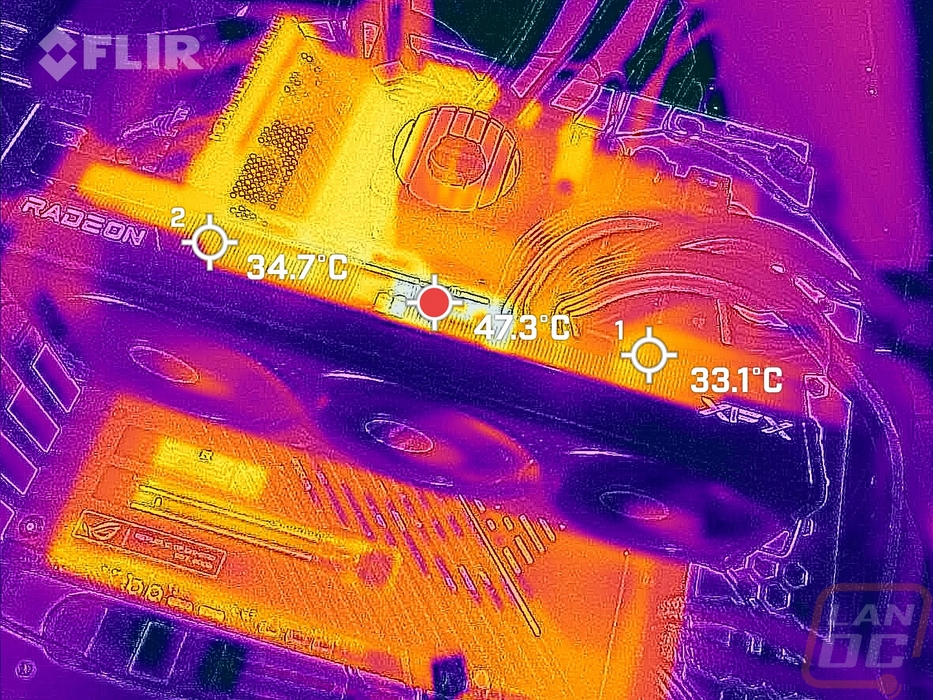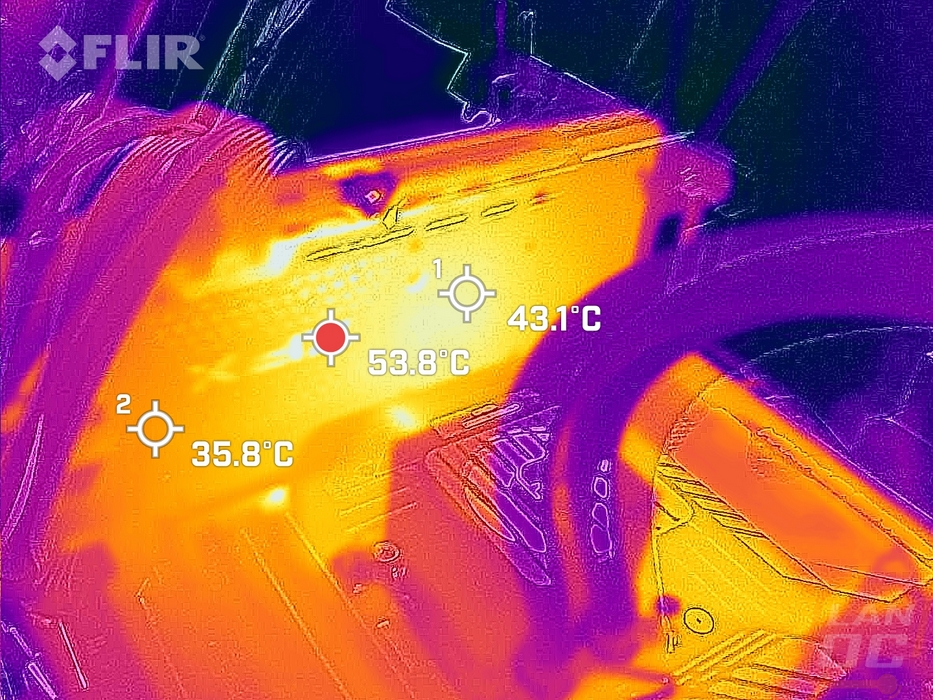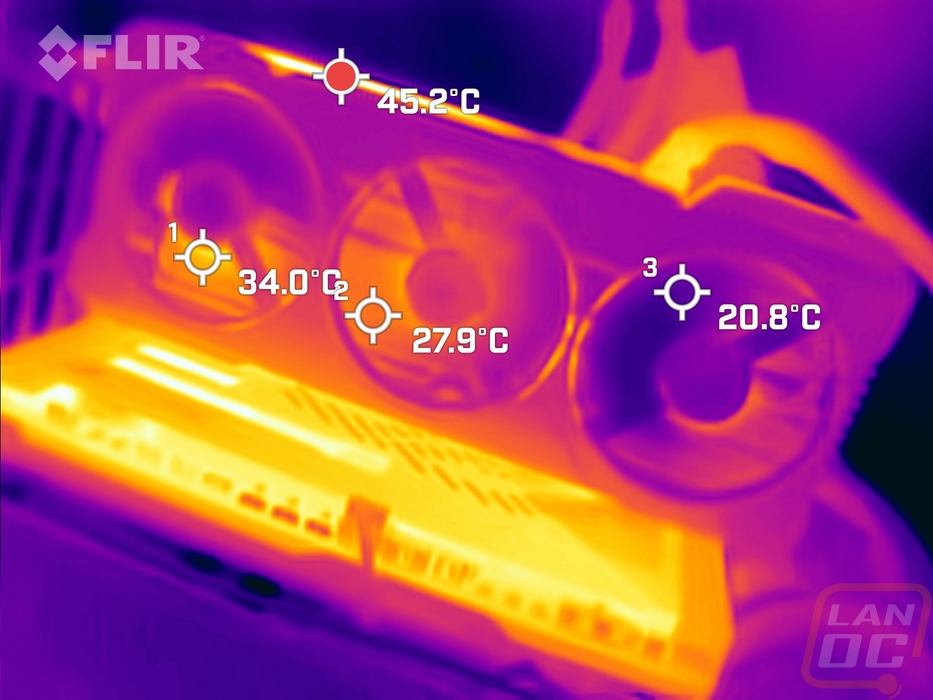Cooling Noise and Power
For my last few tests, rather than focusing on in game performance, I like to check out other aspects of video card performance. These are also the most important ways to differentiate the performance between cards that have the same GPU. To start things off I took a look at power usage.
For this, our new test setup utilizes the Nvidia-designed PCat v2 along with cables to handle both traditional 6 or 8-pin connections as well as the new 12VHPWR. The PCat also utilizes a PCIe adapter to measure any power going to the card through the PCIe slot so we can measure the video card wattage exclusively, not the entire system as we have done in the past. I test with a mix of applications to get both in game, synthetic benchmarks, and other workloads like Blender and AIDA64. Then everything is averaged together for our result. I also have the individual results for this specific card and I document the peak wattage result as well which is almost always Time Spy Extreme. For the the XFX Qick319 RX 7600 XT Black I did have the issue with Blender not working with the pre-launch driver so for that specific test I ran it on the launch driver. The card pulled a lot less in Blender than even I expected with it peaking at just 177 watts. This helped drop its average down slightly and put it right with the RTX 3060 Ti on the average peak wattage. This was still 20 watts more than the RX 7600, the RX 7600 XT does have a higher TGP and with this being an overclocked card it is just adding even more to that.


With having exact peak wattage numbers when running Time Spy Extreme I was also able to put together a graph showing the total score for each watt that a card draws which gives us an interesting look at overall power efficiency in the popular and demanding benchmark. The Blender issue doesn’t have any effect on our score per watt test so this at least gives us a clear look at how the the XFX Qick319 RX 7600 XT Black did. It gets 30.32 points per watt which puts it just over the overclocked RX 6950 XT and below Nvidia’s last generation of cards. This is a full 5 points per watt lower than the stock RX 7600, efficiency has dropped noticeably here even from where the RX 7600 was which wasn’t up in the same range as Nvidia’s current generation of cards.

My next round of tests were looking at noise levels. These are especially important to me because I can’t stand to listen to my PC whirling. Especially when I’m not in game and other applications are using the GPU. For my testing, though I first tested with the fan cranked up to 100% to get an idea of how loud it can get, then again at 50% to get an idea of its range. With the fans at 50% fan speed, the XFX Qick319 RX 7600 XT Black is up in the top 1/3 of the chart at 46.6 which is a lot noisier than I expected but right in line with the RX 6650 XT Gaming X which is sitting right above it. Turning the fans up to 100% was similar with a 62.8 dB result that is again up in the top 1/3 of the chart. The XFX Qick319 RX 7600 XT Black is actually in the bottom half of the chart for fan RPM, so the noise isn’t RPM related.



I also take a look at noise performance while under load. For that when running AIDA64’s stress test I wait until the temperature of the card has leveled off and then measure how loud things are when the card is at its worst-case scenario with the stock fan profile. Here the XFX Qick319 RX 7600 XT Black did better, even if the fans are noisy if the cooling performance is impressive it can make up the difference and really this is the only number that really matters. The XFX Qick319 RX 7600 XT Black fans were running at just 41% when under load and the noise level was 41.7 dB which still isn’t great but does bring it down closer to the middle of the chart slightly.


To finish up my testing I of course had to check out the cooling performance. To do this I ran two different tests. I used AIDA64’s Stress Test run for a half-hour each to warm things up. Then I documented what temperature the GPU leveled out at with the stock fan profile and then again with the fans cranked up to 100%. With the stock profile, the XFX Qick319 RX 7600 XT Black is down at the bottom of the chart running nice and cool at 54c. The GPU hotspot was at 84c and the memory was running a little cooler at 71. The big surprise here though was that there is a memory sensor at all, most of the AMD cards haven’t had one which you can see from our charts. The 54c GPu temperature also tells us that the fan profile could be toned down a little more to keep the noise levels down even lower when under load. XFX does have the dual BIOS on this card, having a second profile with a toned-down fan profile would be awesome.



Then with the fans cranked up, the XFX Qick319 RX 7600 XT Black is running even cooler with it leveling out at 45c in my test. The GPU hotspot was 75c, 9c lower than with the stock fan profile and the memory was also cooler at 64c which is down 7c. The delta between the stock fan profile and the 100% fan speed results is 9c and again I think the stock fan profile could be a little toned down but it does show just how much cooling capacity this card has.


While running the stock fan profile testing I also took the time to get a few thermal images so we could see what is going on. The hottest spot on the Qick319 RX 7600 XT Black is on the backplate where there is the XFX logo-shaped opening that gives us a peak at the PCB. The rest of the back panel isn’t too bad with behind the GPU at 43c and on the end closer to the blow-through area even cooler at 35.8c. The front of the card is even cooler with the warmest area being behind the left fan and the right fan running at room temperature. Then up on the top edge, it’s a little warmer with the exposed heatsink and with that being one area where the warmed air is being pushed with the PCB in the center being the hottest at 47c there.





